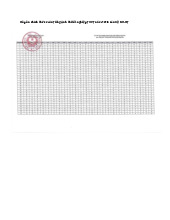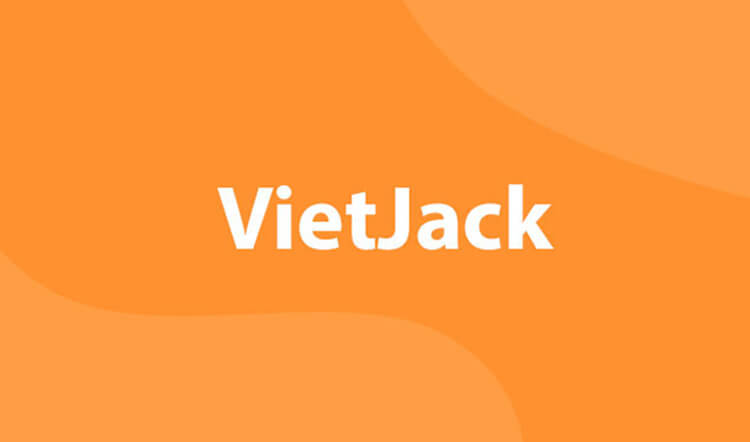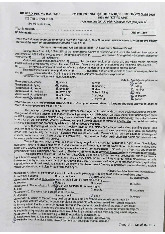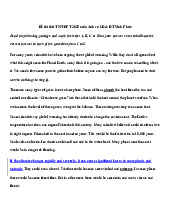











Preview text:
Đề phát triển đề minh họa tiếng Anh 2025
Read the following advertisement and mark the letter A, B, C and D on your answer sheet to indicate the
option that best fits each of the numbered blanks from 1 to 6. MAKING HONEY
Do you like honey? Honey is a natural product, and it is made by honey bees. It has (1) ______, which some
people prefer to ordinary sugar. Sometimes it’s possible to know (2) ______ the flavour what kind of flowers
the bees visited before producing the honey. Have you ever (3) ______ about how honey is produced?
Beekeepers – people who look after bees - are very important in the making of honey. They let the bees in their
care (4) ______ more honey than is needed. Then the honey can be removed without causing problems for the
bees. Honey collection is an ancient activity, (5) ______ back to at least 10.000 years. Thus, honey has become
increasingly (6) ______ nowadays as a healthy food, so people of all age can use it not only to treat some
simple ailments but also to slow down aging process. 1. A. sweet flavour special B. special flavour sweet C. sweet special flavour D. special sweet flavour 2. A. with B. from C. by D. about 3. A. wondered B. asked C. supposed D. told 4. A. to producing B. producing C. produce D. to produce 5. A. dating B. dated C. which dating D. date 6. A. popularise B. popular C. popularity D. popularly
Read the following leaflet and mark the letter A, B, C or D on your answer sheet to indicate the option that
best fits each of the numbered blanks from 7 to 12.
From Many, One: The Rich Tapestry of Global Cultures
⮚ Cultures around the world are interconnected, with some sharing more similarities than (7)_________. By
embracing these differences, we can bring people together and create a stronger global community. One key
element in understanding diversity is cultural (8)_________, which represents the traditions, languages, and
customs (9)_________ through generations.
⮚ (10)_________ celebrating individual cultures, we should recognize the importance of global cooperation.
(11)_________of these traditions enriches our understanding of the world. Through (12)_________forms of art,
people express their unique cultural identities, adding to the global mosaic. 7. A. the others B. others C. another D. other 8. A. identity B. perspective C. heritage D. exchange 9. A. burned out B. came up C. cleaned up D. passed down 10. A. In addition to B. In spite of C. In terms of D. By means of 11. A. Ignorance B. Knowledge C. Disregard D. Rejection 12. A. many B. much C. few D. little
Mark the letter A, B, C or D on your answer sheet to indicate the best arrangement of utterances or sentences
to make a meaningful exchange or text in each of the following questions from 13 to 17. 13.
a. Linh: Hi, Peter! It’s been ages. You look amazing!
b. Linh: Yes, I just got back from a trip to Europe!
c. Peter: Hi, Linh! Thanks a lot. You look great, too. Have you been traveling? A. c-a-b B. a-c-b C. c-b-a D. b-c-a 14.
a. Susan: You’re right. But life in the city can be exciting, too.
b. Susan: What do you think about life in the city, Phi?
c. Susan: There’s alot of entertainment in the city.
d. Phil: Life in the city can be stressful because there’s heavy traffic. e. Phil: What do you mean? A. c-b-a-e-d B. c-e-d-b-a C. d-b-a-e-c D. b-d-a-e-c 15. Hi Sarah,
a. I’ve been reading the book you recommended, and I’m really enjoying it so far.
b. The characters are so well developed, and the story is really engaging.
c. I’ve just reached the part where the main character moves to a new city.
d. Thanks for suggesting it; I haven’t been able to put it down!
e. I can’t wait to finish it and talk about it with you. Talk soon, Anna A. b- a- d- c- e B. a- d- b- c- e C. a- b- c- e- d D. d- a- b- c- e 16.
a. Over the past few years, I’ve journeyed to various parts of the world, from the busy streets of Tokyo to the beautiful beaches of Bali.
b. My love for adventure and curiosity about different ways of life have fueled my desire to explore,
making each trip more rewarding than the last.
c. Traveling to new countries and experiencing diverse cultures has always been my greatest passion.
d. Each destination offers unique adventures, whether it’s tasting street food, exploring historical sites, or
connecting with locals who share their stories.
e. In conclusion, being a traveler not only enriches my life but also broadens my perspective, reminding
me of the beauty of our diverse world. A. d-c-b-a-e B. a-b-c-d-e C. b-c-d-a-e D. c-a-d-b-e 17.
a. However, despite these advancements, the region still struggles with infrastructure challenges, as public
transportation remains underdeveloped.
b. Over the past decade, Greystone has undergone a remarkable transformation, shifting from a quiet
suburban town to a vibrant hub of commercial activity.
c. The influx of new residents has increased demand for housing, resulting in a rapid expansion of
residential developments across the city.
d. This economic growth has attracted businesses from tech startups to retail giants, significantly
enhancing employment opportunities and boosting the local economy.
e. The surge in population, along with the expansion of commercial sectors, has led to a noticeable strain
on public services and transportation networks. A.b-d-c-e-a B. b-c-d-a-e C. b-c-e-a-d D. b-e-d-c-a
Read the following passage about the workplace environment in the 5.0 era and mark the letter A, B, C or D
on your answer sheet to indicate the option that best fits each of the numbered blanks from 18 to 22.
In the rapidly changing world of Industry 5.0, the workplace has evolved with technological
advancements and human-centric approaches. As artificial intelligence (AI) and automation play a larger role,
(18)_________. One significant aspect is the integration of smart technologies that foster collaboration between
humans and machines, creating a more efficient environment. (19)_________.
At the heart of this transformation is flexibility. (20)_________. This shift reflects the growing
recognition that a productive workplace adapts to its workers’ needs. Moreover, workplaces in the 5.0 era are
also sustainable. Companies focus on creating green offices (21)_________. This includes energy-efficient
buildings, sustainable materials, and wellness programs.
Communication has also changed. In the past, office meetings were held in one location. Today, digital
tools enable remote teams to collaborate across different time zones. This evolution is especially beneficial for
global companies, as employees work together without geographical limitations. With real-time tools,
employees share ideas, solve problems, and make decisions faster.
As AI evolves, (22)________. By incorporating AI into the workplace, companies can increase
productivity while fostering an environment where employees explore new opportunities for innovation.
Despite concerns about job displacement, Industry 5.0 emphasizes human potential, ensuring that technology
complements the human workforce. 18.
A. workspaces are being redesigned to accommodate both machines and human creativity
B. workspaces which are redesigned to accommodate both machines and human creativity
C. workspaces having redesigned to accommodate both machines and human creativity
D. workspaces that are being redesigned to accommodate both machines and human creativity 19.
A. Employees now use advanced tools and systems, enabling them to completing tasks faster and with more accuracy
B. Employees now use advanced tools and systems, that enable them to complete tasks faster and with more accuracy
C. Employees now use advanced tools and systems, enabling them to complete tasks faster, they also need to improve their skill
D. Employees now use advanced tools and systems, which enable them to complete tasks faster and with more accuracy 20.
A. Many companies are introducing stricter work schedules and maintain discipline in the workplace
B. Many companies provide flexible working hours, remote work options, and personalized spaces to
meet the diverse needs of their workforce
C. Many companies are increasing mandatory meetings and encourage their workers to work better
D. Many companies provide traditional office setups, focusedon a uniform work environment instead of flexibility 21.
A. that minimized environmental impact while promoting well-being
B. that minimize environmental impact while promoting well-being
C. that are minimizing environmental impact while promoting well-being
D. that which minimize environmental impact while promoting well-being 22.
A. future workplaces will likely see more automation, having allowed employees to focus on creative work
B. future workplaces will likely see more automation, allowed employees to focus on creative work
C. future workplaces will likely see more automation, allowing employees to focus on creative work
D. future workplaces will likely see more automation, allowing employees to have focused on creative work
Read the following passage and mark the letter A, B, C or D on your answer sheet to indicate the best answer
to each of the following questions from 23 to 30.
The traditional 9-to-5 workday has been the standard for decades, but this is rapidly changing. With
advancements in technology and the shift caused by the pandemic, more employees are embracing flexible
work arrangements. Remote work, flexible hours, and freelancing are becoming popular options that allow
workers to balance their professional and personal lives more effectively. These changes have also led to a
rethinking of what it means to be productive, with many employees now able to work from anywhere in the world.
While flexibility offers many advantages, such as improved productivity and better work-life balance, it
also presents challenges. Many employees find it hard to maintain clear boundaries between work and personal
time. Additionally, the isolation of working from home can lead to feelings of disconnection from colleagues,
making it harder to build relationships and collaborate effectively. Some employees even report that they feel
disconnected from their company’s culture, which can affect overall engagement.
As businesses transition to these new work models, the key is how to create policies that maintain
flexibility while fostering collaboration and accountability. Companies need to strike a balance between
giving employees freedom and ensuring they remain productive and engaged. This new approach to work
demands innovation from both employers and employees.
In conclusion, the future of work is undoubtedly more flexible, but it requires thoughtful planning. By
addressing the challenges and embracing the benefits, organizations can create environments where employees
thrive both personally and professionally. 23.
Which of the following is NOT mentioned as a benefit of flexible work? A. Improved productivity B. Enhanced company culture C. Better work-life balance
D. Ability to work from anywhere in the world 24.
The word “freelancing” in paragraph 1 is OPPOSITE in meaning to _________. A. independent work B. full-time employment C. project- based work D.work-life balance 25.
The word “it” in paragraph 2 refers to _________. A. Flexibility
B. The isolation of working from home C. Remote work D. Work-life balance 26.
Which of the following best paraphrases the underlined sentence in paragraph 3?
A. Businesses must decide how to balance flexibility with the need for teamwork and responsibility in new work models.
B. Companies need to focus on maintaining productivity and reducing isolation as they adopt flexible work practices.
C. The challenge for businesses is to find ways to embrace new work models without sacrificing the company culture.
D. The main concern for businesses is how to keep employees motivated while working from home. 27.
The word “undoubtedly” in paragraph 4 could be best replaced by _________. A. likely B. possibly C. certainly D. arguably 28.
Which of the following is TRUE according to the passage?
A. Flexible work arrangements have led to decreased productivity.
B. Remote work and freelancing are becoming less popular options.
C. Maintaining work-life balance is one of the challenges of flexible work.
D. The shift to flexible work arrangements has caused employees to feel more connected to their company’s culture. 29.
In which paragraph does the writer mention a popular flexible work option? A. Paragraph 1 B. Paragraph 4 C. Paragraph 2 D. Paragraph 3 30.
In which paragraph does the writer mention the challenges related to remote work? A. Paragraph 4 B. Paragraph 2 C. Paragraph 1 D. Paragraph 3
Read the fol owing passage and mark the letter A, B, C or D on your answer sheet to indicate the best
answer to each of the following questions from 31 to 40.
Urbanization in China has been one of the most remarkable phenomena of recent decades. With a
population of over 1.4 billion people, the country has seen rapid economic growth, leading to significant urban
development. Megacities like Beijing, Shanghai, and Guangzhou have expanded, while smaller cities have also
grown quickly. This transformation is not just about new buildings and infrastructure but also about deep social,
cultural, and environmental changes.
Historically, China was an agrarian society, with most people living in rural areas. Since the late 20th
century, government policies have encouraged migration from rural areas to urban centers in search of better
job opportunities and living standards. The "hukou" system, which once restricted the movement of people
between rural and urban areas, has been gradually relaxed, allowing millions to move to cities.
[I] Urbanization has brought economic growth, with cities becoming centers of industry and innovation.
This has fueled the growth of a robust middle class, offering better access to education, healthcare, and jobs. [II]
However, the rapid pace of urbanization also brings challenges, especially in terms of environmental impact.
[III] Air pollution, waste management, and water contamination are becoming major issues. Despite stricter
environmental regulations and green initiatives, addressing these problems remains a difficult task.[IV]
Another challenge is the growing inequality between urban and rural populations. While city dwellers
benefit from better living conditions, many rural residents still face poverty and limited access to resources. The
gap in income and access to public services is widening, leading to social divides. Additionally, the cultural
shift towards urban living is creating a generational divide, with younger generations disconnected from their rural roots.
The rise of “ghost cities”—newly built cities with modern infrastructure but few residents—raises
questions about the sustainability of China’s urbanization model. These cities are often the result of speculative
real estate investments, and their empty nature shows the challenges of rapid urban expansion.
In conclusion, urbanization in China offers both opportunities and challenges. It has fueled economic
growth but also created environmental and social issues. As urbanization continues, China must balance
development with sustainability, ensuring that the benefits of urbanization are shared more equally across the population. 31.
The phrase“leading to” in paragraph 1 could be best replaced by_________. A. bringing about B. paying to C. taking in D. taking up 32.
Where in paragraph 3 does the following sentence best fit?
Millions have been lifted out of poverty, and living standards have improved for many. A. [I] B. [II] C. [III] D. [IV] 33.
Which of the following is NOT mentioned as a result of China’s rapid urbanization?
A. The widening gap between urban and rural populations.
B. The decline of traditional agricultural practices.
C. Environmental issues, such as air pollution and water contamination.
D. Economic growth and the rise of a robust middle class. 34.
Which of the following best summarises paragraph 2?
A. China’s historical focus on agriculture has limited the growth of urban areas.
B. Government policies have encouraged rural-to-urban migration, easing restrictions on movement.
C. The "hukou" system was abolished to prevent overcrowding in cities.
D. The rapid growth of megacities has led to a significant decline in rural populations. 35.
Which of the following best paraphrases the underlined sentence in paragraph 4?
A. The migration to urban areas is causing older generations to feel left behind, while younger people adapt to modern city life.
B. The younger generations are struggling to adapt to urban life, while older generations embrace modernity.
C. Urban living has led to a growing divide between rural and urban areas, with both generations
benefiting equally from the shift.
D. The move towards urban lifestyles is causing a generational gap, as younger people lose their
connection to their rural backgrounds. 36.
The word “speculative” in paragraph 5 is OPPOSITE in meaning to_________. A. well-founded B. hazardous C. theoretical D. precarious 37.
Which of the following is TRUE according to the passage?
A. The "hukou" system still severely restricts migration between rural and urban areas.
B. Rapid urbanization in China has only led to positive economic outcomes.
C. Air pollution, waste management, and water contamination are major environmental issues in China due to urbanization.
D. The rise of “ghost cities” in China has solved the problem of overcrowded urban areas. 38.
The word “It” in paragraph 6 refers to_________. A. Conclusion B. China’s urbanization C. China
D. The sustainability of China’s urbanization model 39.
Which of the following can be inferred from the passage?
A. China’s urbanization has been entirely beneficial to the country’s population.
B. The rapid urbanization in China has caused significant environmental and social problems.
C. Rural residents in China now have better access to the same opportunities as urban dwellers.
D. Ghost cities in China are thriving due to the high demand for housing. 40.
Which of the following best summarises the passage?
A. Urbanization in China has resulted in substantial economic benefits but has also caused social and
environmental problems, leading to challenges in balancing growth and sustainability.
B. The rapid expansion of Chinese cities has primarily benefited the urban population, leaving rural areas unaffected.
C. The government’s relaxation of the "hukou" system has resolved most of the issues caused by urban migration.
D. China’s ghost cities represent the successful implementation of the country’s urbanization policies and
have contributed to its economic development. ĐÁP ÁN 1. D 11. B 21. B 31. A 2. B 12. A 22. C 32. B 3. A 13. B 23. B 33. B 4. C 14. D 24. B 34. B 5. A 15. B 25. A 35. D 6. B 16. D 26. A 36. A 7. B 17. A 27. C 37. C 8. C 18. A 28. C 38. B 9. D 19. D 29. A 39. B 10. A 20. B 30. B 40. A




